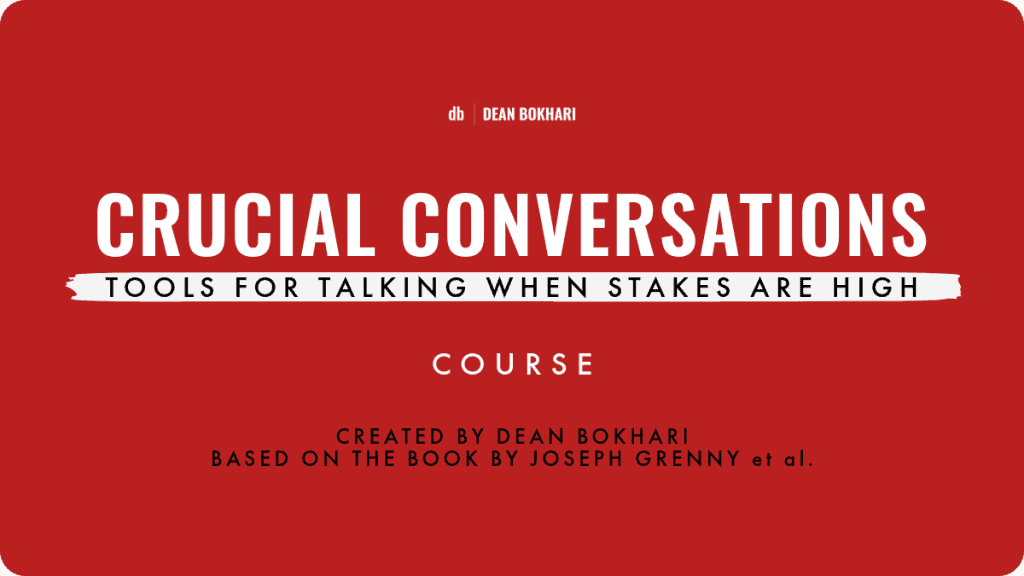4. Make people feel like you respect them to create a safe conversation
Welcome back to this short course on Crucial Conversations: Tools for Talking When Stakes are High. Here’s what we’ve covered so far:
- 1. How crucial conversations turn into emotionally-charged debates.
- 2. Be calm + focus on your ultimate goal in a crucial conversation.
- 3. Why crucial conversations fail.
Now, let’s dive into lesson 4…
”Skilled people Start with Heart. That is, they begin high-risk discussions with the right motives, and they stay focused no matter what happens.”
— Joseph Grenny, et al., Crucial Conversations
If people feel threatened during a conversation, they resort to silent or violent reactions, and the conversation fails.
So how do we ensure that the atmosphere of a conversation remains safe?
First things first: we start by laying the foundation of your conversation on two things:
(1) a common purpose, and (2) mutual respect.
Let’s break both of these down:
- Common purpose. Finding a common purpose is important because it’s what binds two or more people together in any given conversation. If the participants in a conversation genuinely feel that they have a common purpose, they will try to look above their differences and communicate with each other in order to achieve that purpose. Put simply, every participant needs to feel like they’re contributing to any decisions that get made as a result of the conversation; people need to feel like they’ve got some skin in the game.
- Mutual respect. Mutual respect is just as important as finding a common purpose. Respect is absolutely critical for any successful conversation. If your conversation partners feel like you don’t respect them, you’ll either get a silent reaction (no communication, sarcasm) or a violent reaction (angry words, shouting contest). So you must make an effort to avoid making anyone feel disrespected—period.
Even when you’re about to criticize an employee, you can do so without disrespecting them.
A good way to do this is by using the technique of alternating between praise and criticism.
For example, let’s say you want Jimmy to be more punctual. Here’s how it might go:
- YOU: “I appreciate all your hard work on XYZ project, Jimmy.”
- JIMMY: “Thanks so much!”
- YOU: “You know, if there were just one area I’d like to see you improve upon, it would be your punctuality. Do you think you could work on ensuring you’re at our project meetings on time from now on? It would really help maintain the high-quality work you’re known for as you continue to take on new projects in the future.”
- JIMMY: “Absolutely, boss. I apologize for showing up late and will make sure it doesn’t happen again. I’ll be on time, every time.”
- YOU: “Thank you, Jimmy… And hey—keep up the quality work, it’s really showing.”
BOOM.
Start out positive.
Place the area of improvement in the middle.
Finish off strong with another positive statement.
Both personally and professionally, your conversations will be more positive, and you’ll increase your chances of achieving win-win solutions if you make an effort toward the common goals and interests of the people involved.
Try to define a common solution and once this is clear, those who are a part of the conversation will strive towards that as well.
For example, let’s say you were just offered a once-in-a-lifetime promotion at work; the kind of opportunity that could really take your career to the next level.
But the downside is that you and your family will have to move to another state.
This puts you at odds with your partner.
Initially, you and your partner seemingly have completely different goals: You want the promotion while your partner doesn’t want to move.
At this point, it’s important to work on finding a more general goal that is in both your interest as well as your partner’s.
For instance, define the long-term needs of the family, and see if your promotion aligns with those needs. Talk it out. Work on coming up with something together.
This will immediately help you and your partner establish common ground.
And no matter what the outcome of your discussion, you’ll both be more likely to sincerely consider the available options.
In the end, your partner may be persuaded to let you take the promotion and move; or you may decide that finding a better opportunity in the same area is a better option.
Either way, it’ll be a stronger decision because both you and your partner were involved in making it.
If you’re enjoying this free course on Crucial Conversations, you’ll love the full version of this training program. Learn more and register below 👇
Regularly: $294.00
Now only: $242.00

